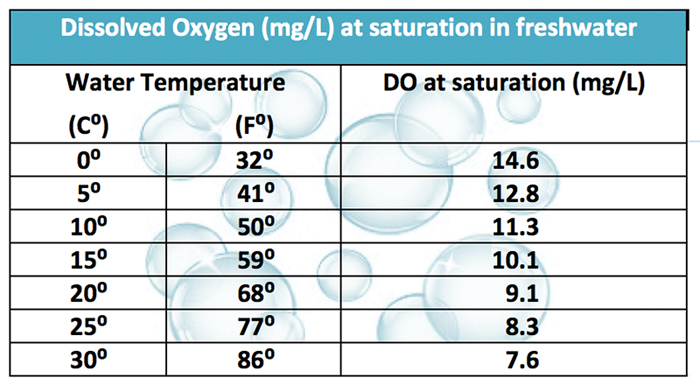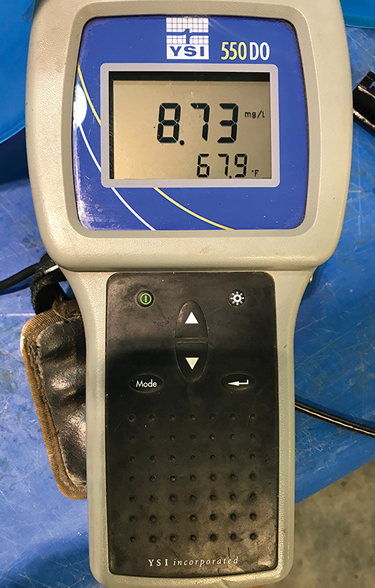
Fish need oxygen! Adequate amounts of dissolved oxygen are crucial for all pond and fish life. Unfortunately, oxygen is one of the most overlooked parameters of water quality in the retail setting, as well as in koi ponds. Low dissolved oxygen (DO) is an underestimated cause of many fish losses. As a koi seller, it is imperative that you regularly test your holding tanks for nitrogen, ammonia and pH — and monitor the dissolved oxygen level.
>> Follow us here for more content on fish, koi and other pond life!
Knowing oxygen requirements for optimum fish health will go a long way in your desire to keep and maintain healthy koi and to offer them for sale to your ponding customers.
The minimum DO concentration for healthy growth, tissue repair and reproduction in koi is 6 mg per liter of water (6 mg/L), but ideally the concentration should be higher. A DO reading of 7 mg/L is desirable, and any reading above that should be considered excellent.There are many factors that affect the DO concentration in fish retailing tanks. Fish load is not the only consideration. Salinity, water temperature and atmospheric temperatures also affect dissolved oxygen. Warm water does not hold as much oxygen as cool water. All fish require more oxygen in higher temperatures when they are very active. In cool water, fish are less active, and their oxygen requirement is minimal.
Fish use up oxygen with ordinary activity, such as breathing and feeding. A lot of oxygen is consumed if the fish’s flight instinct kicks in when they are netted and bowled. Fish waste and decaying organic matter also have a draining effect on DO. You may not realize it, but biofiltration also consumes oxygen. Nitrifying bacteria require ample oxygen to colonize and do their job of purifying water effectively.
Recognize the Signs

There are several indicators of low oxygen in fish tanks and ponds. One of the first things you may notice is that the fish are congregating near an oxygen source, such as the water inlet or airstone. Often times, fish will be slow or sluggish and disinterested in food. But more obvious signs of oxygen depletion include fish gasping at the surface or piping at the top of the water.
Generally, prolonged exposure to low DO is harmful to all fish. A habitually low oxygen level can be linked to slow fish growth and persistent fish sickness, and it may contribute to repetitive parasite outbreaks. Continued exposure to low DO is also considered a precursor to bacterial infections in fish. Even short periods of oxygen deprivation can have damaging effects.

Koi can survive for weeks or even months without food — but only a few minutes without oxygen!
During respiration, water is forced through the gills. The delicate gill filaments transfer oxygen from the water to the bloodstream. Normal healthy gill tissue is a deep pink-to-reddish color. Pale gill color can be an indication of low DO or suffocation.
Air Pumps & Diffusers

Electric air pumps with attached airstones or diffusers are the most common form of aeration for fish retailing tanks. Sizing the equipment to each retail system is completely customizable. The diffuser reduces or breaks up the air that is being pushed through the pump into tiny bubbles that disperse into the water for fish to utilize. These tiny bubbles produce the best possible oxygen transfer into the water. Depending on the size of your holding tanks, multiple airstones may be beneficial.
An air pump that was once adequate may put out less air with constant use and will eventually need to be refurbished or replaced. As pumps wear, they usually produce less and less oxygen. A worn or aged pump may not provide sufficient airflow; at worst case, it may fail entirely.
When air stones begin to plug, you’ll notice that the bubbles become larger in size and fewer in number. A plugged airstone increases pressure on your air pump, making it work harder and lessening the amount of oxygen transfer into your holding tank. Airstones should be cleaned every six months at minimum. Replacing air stones periodically is a small price to pay to ensure that your stock is not oxygen deprived.
Don’t forget to check your air hose occasionally as well. The smallest crack or split in an airline can have devastating effects. Sun rot is often the cause of air hose damage.
Oxygen depletion can also occur with the addition of new water into your fish retail systems. Please note that tap water and well water contain frighteningly low levels of DO. You should pay close attention to the oxygen level whenever a water change is being performed.
Oxygen Monitoring Devices
 There are various testing products available to measure the DO concentration in your water, and they vary in cost. One of the most inexpensive options is a titrate test kit. Several companies offer their own brand of oxygen test kits, as well as the reagent supplies. When used correctly, the kits are fairly reliable in obtaining a DO reading in mg/L.
There are various testing products available to measure the DO concentration in your water, and they vary in cost. One of the most inexpensive options is a titrate test kit. Several companies offer their own brand of oxygen test kits, as well as the reagent supplies. When used correctly, the kits are fairly reliable in obtaining a DO reading in mg/L.
Our preferred oxygen test unit at Kloubec Koi Farm is a battery-operated, handheld meter. The meter displays an instant reading when the attached sensor probe is inserted into the water column for a few seconds. There are several brands of digital meters available on the market, though they are generally priced around $1,000 instead of $100. As a reputable fish retailer, you should invest in whichever type fits your needs.
>> For more information on this and other koi health topics, please visit the Kloubec Koi Farm’s koi health website at www.koihealth.info.


